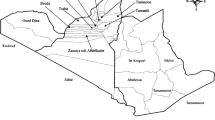Abstract
After 23 years of war, current information about the biodiversity of crops in the Hindukush mountains of Afghanistan is scarce. This study aimed at assessing the genetic composition of farmers wheat (Triticum spp.) populations through a survey of 21 randomly chosen cereal fields on both sides of the Panjsher river in the upper Panjsher valley of Northern Afghanistan. A stratified sampling of wheat heads according to morphological differences was followed by estimates of field size and grain yield and a formal interview with the landowner about the cropping sequence and the inputs used. About 75% of the cereal fields were cropped in rotation systems with faba bean (Vicia faba L.), barley (Hordeum vulgare L.), potato (Solanum tuberosum L.), maize (Zea mays L.) or fallow. Manure application at between 2.3 and 5.3 t ha−1 was the major source of nutrient inputs at grain yield levels between 1.2 and 4.7 t ha−1. The morphological characterization of the collection revealed 19 taxonomically different varieties of bread wheat (Triticum aestivum L.) but also barley and triticale (Triticosecale Wittm.) grown in mixtures. Populations within one field consisted of up to seven botanical wheat varieties. Farmers did not differentiate between morphological differences within such mixtures but identified their populations instead according to grain color, cooking properties and resistance to mildew and frost. Triticum aestivum var. subferrugineum was the most widespread wheat variety and no effects of altitude on biodiversity of wheat was noted across the transect. Particularly interesting was the occurrence of T. aestivum var. subferrugininflatum and var. subgraecinflatum which so far have only been reported from Mongolia. The finding of triticale indicated the active seed exchange with lowland or long-distance seed sources.
Similar content being viewed by others
References
Blom E. et al. 2000. Nature in War. Biodiversity Conservation during Conflicts, Mededelingen No. 37, Leiden, Netherlands,172 pp.
V.F. Dorofeev A.A. Filatenko E.F. Miguschova R.A. Udachin M.M. Jakubziner (1979) Wheat Flora of Cultivated Plants Kolos Leningrad 346
ICARDA 2002. http://www.icarda.org/News/Seed%20Info/23/contribution/bafghan.htm and http://www.icarda.org/Afghanistan/index.html.
D.R. Lightfoot (2000) ArticleTitleThe origin and diffusion of qanats in Arabia: New evidence from the northern and southern Peninsula Geogr. J. 166 215–226
N.I. Vavilov (1923) ArticleTitleTowards our understanding of soft wheats (Systematic-geographical outline) Trudy prikl. bot. sel. 13 IssueID1 149–257
N.I. Vavilov (1997) Five Continents IPGRI Rome 198
Vavilov N.I. and Bukinich D.D. 1929. Agricultural Afghanistan. Bull. Appl. Bot. Genet. Plant Breeding Supp. 33: 378–382, 474, 480, 584–585, 604 (in Russian).
Author information
Authors and Affiliations
Corresponding author
Rights and permissions
About this article
Cite this article
Buerkert, A., Oryakhail, M., Filatenko, A.A. et al. Cultivation and Taxonomic Classification of Wheat Landraces in the Upper Panjsher Valley of Afghanistan After 23 Years of War. Genet Resour Crop Evol 53, 91–97 (2006). https://doi.org/10.1007/s10722-004-0717-3
Received:
Accepted:
Issue Date:
DOI: https://doi.org/10.1007/s10722-004-0717-3




